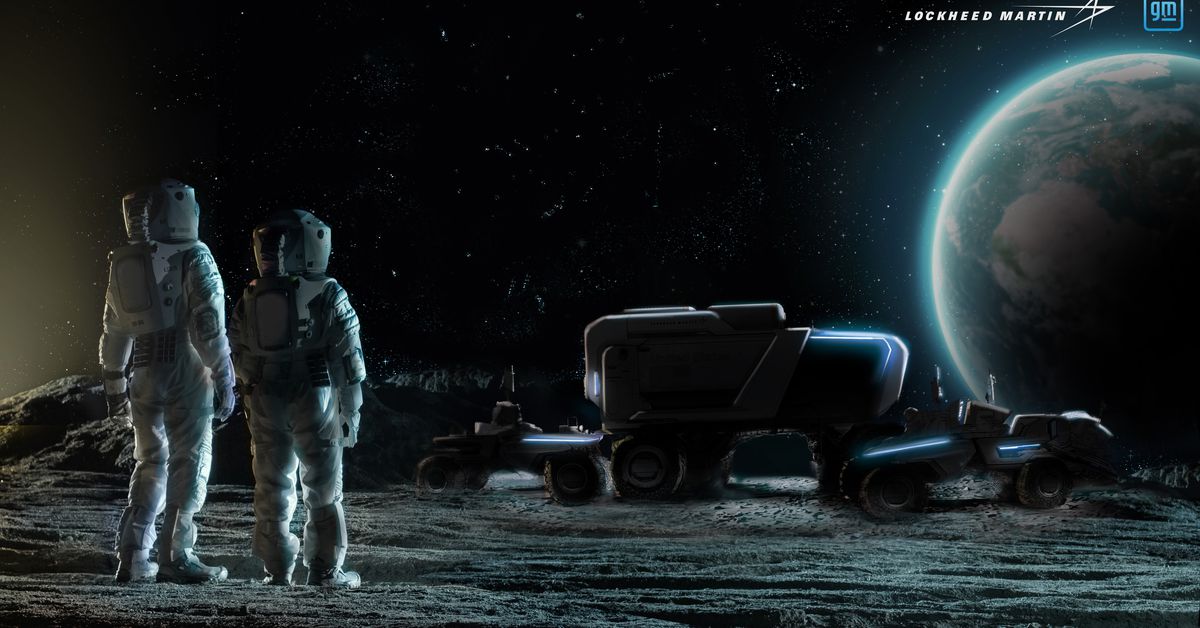Lockheed Martin and GM are working on an electric Moon buggy
Source: The Verge added 26th May 2021Lockheed Martin and General Motors unveiled plans on Wednesday to build an autonomous buggy-like vehicle that future astronauts can use to zip around the surface of the Moon. The two companies collaborated to pitch a conceptual Lunar Terrain Vehicle to NASA’s Artemis program, a Moon exploration campaign that calls for various robots, vehicles, and scientific bases to be planted on the lunar surface within the next decade.
Ahead of a presentation Wednesday morning, Lockheed and GM said in a joint press release that the vehicle will use the automaker’s autonomous driving technology and is “being designed to traverse significantly farther distances” than Apollo-era buggies. Just like those Moon buggies from the ‘70s, the Lockheed-GM concept will be fully electric.
The rover is still in the early stages of development, so details on its size, weight and range aren’t set in stone yet, Jeff Ryder, GM’s Vice President of Growth and Strategy, told reporters in a press conference. It will be “made of very lightweight, strong and resilient materials,” but “exactly what those are is still in formulation,” says Lockheed’s lunar exploration vice president Kirk Shireman. “We want it to be as light and strong and have a long life as it possibly can.”
“These next-generation rovers will dramatically extend the range of astronauts as they perform high-priority science investigation on the Moon that will ultimately impact humanity’s understanding of our place in the solar system,” Rick Ambrose, executive vice president of Lockheed’s space unit, said in a statement. NASA’s Artemis program calls for an initial astronaut Moon landing as soon as 2024 (a goal some say is unrealistic) with follow-up missions to build a sustained presence on the lunar south pole. Those missions will serve as a proving ground for technologies that can inform future missions to Mars.
The heavyweight collaboration between Lockheed and GM came after NASA asked the private sector to come up with ideas for two types of human-rated Moon vehicles: the Lunar Terrain Vehicle (or LTV) and a bigger “Lunar Surface Science Mobility System,” essentially a science lab on wheels. NASA had only a few minimum specifications for LTV concepts. First, they should be capable of driving autonomously on the Moon’s hazardous, crater-laden terrain, a challenging environment for the computer vision technology that powers autonomous driving systems on Earth.
A NASA LTV also needs to be fully electric and capable of recharging itself internally — either from onboard solar arrays or other systems — and externally from infrastructure that can be set up on the Moon, like NASA’s Human Landing System. It should be able to carry two fully suited astronauts, including the driver, as well as any cargo for a total haul capacity of 1,102 pounds on a single charge for at least 1.2 miles. And it needs to withstand the lunar south pole’s volatile surface temperatures, which can vary from 260 degrees Fahrenheit to negative 280 degrees during the Moon’s nighttime.
Lockheed and GM were among the cadre of industry giants that built NASA’s first lunar landing systems and buggies under the Apollo program. GM built the chassis and wheels for the Lunar Roving Vehicles, as they were formally called, on Apollo missions 15 through 17. The rover for Apollo 17, the program’s final Moon mission in 1972, did the most roving: Astronaut Gene Cernan whipped the lightweight electric LRV more than 22 miles total on the Moon, going as far as 4.7 miles away from their lunar module.
Lockheed and GM said their new concept will travel much farther than the buggies of Apollo. “The result” of the companies’ engineering efforts, a press release said, “may allow astronauts to explore the lunar surface in unprecedented fashion and support discovery in places where humans have never gone before.”
Developing…
brands: APOLLO Built Charge Discovery Fashion First General Motors GM It New other Space Strong Taurus Unit Vision media: 'The Verge' keywords: NASA
Related posts
Notice: Undefined variable: all_related in /var/www/vhosts/rondea.com/httpdocs/wp-content/themes/rondea-2-0/single-article.php on line 88
Notice: Undefined variable: all_related in /var/www/vhosts/rondea.com/httpdocs/wp-content/themes/rondea-2-0/single-article.php on line 88
Related Products
Notice: Undefined variable: all_related in /var/www/vhosts/rondea.com/httpdocs/wp-content/themes/rondea-2-0/single-article.php on line 91
Warning: Invalid argument supplied for foreach() in /var/www/vhosts/rondea.com/httpdocs/wp-content/themes/rondea-2-0/single-article.php on line 91
